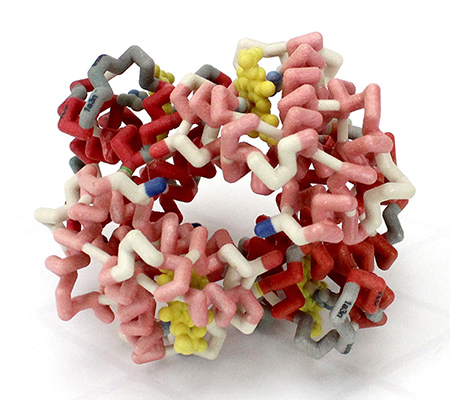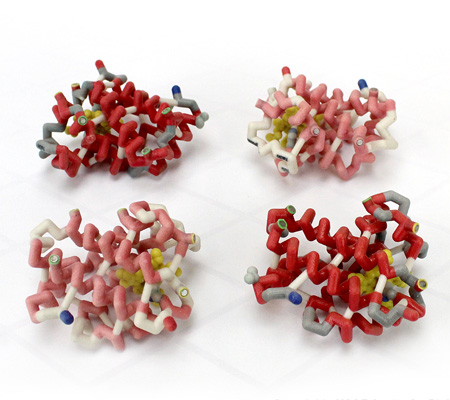Hemoglobin
From Proteopedia
(Difference between revisions)
m |
|||
| Line 48: | Line 48: | ||
For a view down the exact crystallographic 2-fold axis from the β1- β2 end, click here: The yellowtint crosses are phosphate sites present in deoxy but not oxy Hb. In oxy Hb, the β subunits move closer together, squeezing out phosphates (such as 2,3 DPG), and allowing the N- and C-termini to interact. DPG and other phosphates bind much more strongly to the deoxy quaternary structure; therefore they necessarily push the equilibrium toward deoxy Hb, and because of that they decrease O2 affinity. Such regulatory phosphate molecules are useful in the blood, because their concentrations can be controlled to shift the Hb O2-binding curve so that it is working across the steepest and most efficient part under conditions in the lungs and tissues. For instance, at high altitude the body makes more DPG, to unload O2 more effectively in the muscles. | For a view down the exact crystallographic 2-fold axis from the β1- β2 end, click here: The yellowtint crosses are phosphate sites present in deoxy but not oxy Hb. In oxy Hb, the β subunits move closer together, squeezing out phosphates (such as 2,3 DPG), and allowing the N- and C-termini to interact. DPG and other phosphates bind much more strongly to the deoxy quaternary structure; therefore they necessarily push the equilibrium toward deoxy Hb, and because of that they decrease O2 affinity. Such regulatory phosphate molecules are useful in the blood, because their concentrations can be controlled to shift the Hb O2-binding curve so that it is working across the steepest and most efficient part under conditions in the lungs and tissues. For instance, at high altitude the body makes more DPG, to unload O2 more effectively in the muscles. | ||
| - | Like the [[PFK]], to the first approximation the Hb molecule consists of two "dimers" (α1-β1 and α2-β2), which rotate relative to each other as rigid bodies in the R-T transition. The α1-β1 unit undergoes relatively little internal rearrangement, but its overall rotation with respect to the α2-β2 unit is considerable. The net rotation of the two dimers alters their interactions with one another, most notably at the allosteric effector site between β1 and β2 ( | + | Like the [[PFK]], to the first approximation the Hb molecule consists of two "dimers" (α1-β1 and α2-β2), which rotate relative to each other as rigid bodies in the R-T transition. The α1-β1 unit undergoes relatively little internal rearrangement, but its overall rotation with respect to the α2-β2 unit is considerable. The net rotation of the two dimers alters their interactions with one another, most notably at the allosteric effector site between β1 and β2 (PO<sub>4</sub> binding) and at the important α1-β2 interface, where mutations have the largest effect on Hb allosteric properties. Although the symmetry is not exact, similar parts of the subunits contact each other: the C helix, and the "FG corner" between helices F and G. |
Have a look at a closeup that emphasizes the ratchet contact between the C helix of α1 and the FG corner of β2; His 97 of the β2 FG corner makes a large jump against Thr 38 and Thr 41 of the α1 C helix. In a closeup of the hinge contact, the motions are mainly rotations without much shift, between the α1 FG corner and the β2 C helix. Labels help identify these parts. Since this is a complex motion orchestrated between the fit of two quite different sets of contacts in the two states, this interface is critical to making Hb allostery work, and mutations of residues in this interface have been found to be especially likely to influence cooperativity and allostery. | Have a look at a closeup that emphasizes the ratchet contact between the C helix of α1 and the FG corner of β2; His 97 of the β2 FG corner makes a large jump against Thr 38 and Thr 41 of the α1 C helix. In a closeup of the hinge contact, the motions are mainly rotations without much shift, between the α1 FG corner and the β2 C helix. Labels help identify these parts. Since this is a complex motion orchestrated between the fit of two quite different sets of contacts in the two states, this interface is critical to making Hb allostery work, and mutations of residues in this interface have been found to be especially likely to influence cooperativity and allostery. | ||
| Line 79: | Line 79: | ||
*Mutation at <scene name='Journal:JBIC:8/Trhb/11'>Gln50</scene> increased the O<sub>2</sub> dissociation and autooxidation rate constants, and partly disrupted the hydrogen-bonding network. | *Mutation at <scene name='Journal:JBIC:8/Trhb/11'>Gln50</scene> increased the O<sub>2</sub> dissociation and autooxidation rate constants, and partly disrupted the hydrogen-bonding network. | ||
| - | An <scene name='Journal:JBIC:8/Ag/4'>Fe(III)-H2O complex of Tp trHb was formed following reaction of the Fe(II)- | + | An <scene name='Journal:JBIC:8/Ag/4'>Fe(III)-H2O complex of Tp trHb was formed following reaction of the Fe(II)-O<sub>2</sub> complex of Tp trHb</scene>, in a crystal state, with nitric oxide. This suggests that ''Tp'' trHb functions in nitric oxide detoxification. |
==3D Printed Physical Model of Hemoglobin at The MSOE Center for BioMolecular Modeling== | ==3D Printed Physical Model of Hemoglobin at The MSOE Center for BioMolecular Modeling== | ||
Revision as of 20:55, 1 July 2020
| |||||||||||
References, for further information on Hemoglobin
To the structures used here:
- Baldwin (1980) "The crystal structure of human carbonmonoxy haemoglobin at 2.7A resolution", J. Mol. Biol. 136: 103. (1hco) PMID: 7373648
- Fermi, Perutz, Shaanan, & Fourme (1984) "The crystal structure of human deoxy haemoglobin at 1.74A resolution", J. Mol. Biol. 175: 159. (3hhb)
- Jotaro Igarashi, Kazuo Kobayashi and Ariki Matsuoka (2011) "A hydrogen-bonding network formed by the B10-E7-E11 residues of a truncated hemoglobin from Tetrahymena pyriformis is critical for stability of bound oxygen and nitric oxide detoxification", J. Biol. Inorg. Chem. 16(4):599-609 (3aq9) PMID: 21298303
General treatments of Hb allostery:
- Perutz (1970) "Stereochemistry of cooperative effects in haemoglobin", Nature 228: 726
- Baldwin & Chothia (1979) "Haemoglobin. The structural changes related to ligand binding and its allosteric mechanism", J. Mol. Biol. 129: 175. link
- Dickerson & Geis (1983) "Hemoglobin: Structure, Function, and Pathology", Benjamin/Cummings Publ., Menlo Park, CA
- Perutz (1989) "Mechanisms of cooperativity and allosteric regulation in proteins", Quarterly Rev. of Biophys. 22: 139-236
- Ackers, Doyle, Myers, & Daugherty (1992) "Molecular code for cooperativity in hemoglobin", Science 255: 54
- Perutz, Fermi, Poyart, Pagnier, & Kister (1993) "A novel allosteric mechanism in haemoglobin: Structure of bovine deoxyhaemoglobin, absence of specific chloride binding sites, and origin of the chloride-linked Bohr Effect in bovine and human haemoglobin", J. Mol. Biol. 233: 536
Hb structures in other quaternary states or intermediates:
- Silva, Rogers, & Arnone (1992) "A third quaternary structure of human hemoglobin A at 1.7A resolution", J. Biol. Chem. 267: 17248
- Smith, Lattman, & Carter (1991) "The mutation β99 Asp-Tyr stabilizes Y - A new, composite quaternary state of human hemoglobin", Proteins: Struct., Funct., Genet. 10: 81
- Liddington, Derewenda, Dodson, Hubbard, & Dodson (1992) "High resolution crystal structures and comparisons of T state deoxyhaemoglobin and two liganded T-state haemoglobins: T(α-oxy)haemoglobin and T(met)Haemoglobin", J. Mol. Biol. 228: 551
More information on hemoglobin
- Perutz, M.F. (1978) Hemoglobin Structure and Respiratory Transport, Scientific American, volume 239, number 6.
- Squires, J.E. (2002) Artificial Blood, Science 295, 1002.
- Vichinsky, E. (2002) New therapies in sickle cell disease. Lancet 24, 629.
Content Donators
Currently (June 22, 2008) most all of the content of this page comes from three main sources of generously donated content. Their work has been imported into this page. In their order of appearance on the page:
- Content adapted with permission from Eric Martz's hemoglobin tutorial at http://molviz.org
- Content adapted with permission from David S. Goodsell and Shuchismita Dutta's Molecule of the Month on Hemoglobin http://mgl.scripps.edu/people/goodsell/pdb/pdb41/pdb41_1.html
- Content adapted with permission from Jane S. and David C. Richardson's http://kinemage.biochem.duke.edu/
Proteopedia Page Contributors and Editors (what is this?)
Eran Hodis, Michal Harel, Joel L. Sussman, Alexander Berchansky, Jaime Prilusky, Karsten Theis, Eric Martz, Karl Oberholser, Tihitina Y Aytenfisu, Mark Hoelzer, Marc Gillespie, Ann Taylor, Marius Mihasan, Manisha Chawda, Hannah Campbell



